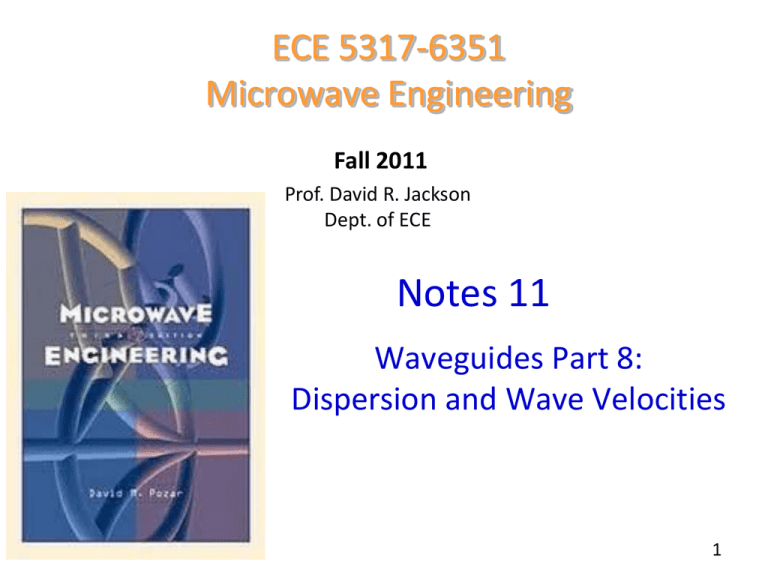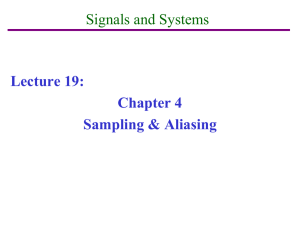Notes 11 - Waveguides Part 8 dispersion and wave velocities
advertisement

ECE 5317-6351 Microwave Engineering Fall 2011 Prof. David R. Jackson Dept. of ECE Notes 11 Waveguides Part 8: Dispersion and Wave Velocities 1 Dispersion Dispersion => Signal distortion due to “non-constant” z phase velocity => Phase relationships in original signal spectrum are changed as the signal propagates down the guide. In waveguides, distortion is due to: Frequency-dependent phase velocity (frequency dispersion) Frequency-dependent attenuation => distorted amplitude relationships Propagation of multiple modes that have different phase velocities (modal dispersion) 2 Dispersion (cont.) Consider two different frequencies applied at the input: + vin - Z 0 , ( ) + vout - L vin A cos 1t a B cos 2t b A cos 1 t a B cos 2 t b 1 2 Z0 Matched load Vina Ae ja Vinb Be jb j L Voaut Ae a 1 j L Vobut Be b 2 vout A cos 1t (1 ) L a B cos 2t (2 ) L b (1 ) L a (2 ) L b A cos 1 t B cos 2 t 1 1 2 2 3 Dispersion (cont.) + Z 0 , ( ) vin - + vout Z0 - Matched load L vout A cos 1t (1 ) L a B cos 2t (2 ) L b (1 ) L a (2 ) L b A cos 1 t B cos 2 t 1 1 2 2 Recall: vp t1 L v p (1 ) t2 L v p (2 ) 4 Dispersion (cont.) No dispersion (dispersionless) v p f ( ) v p (1 ) v p (2 ) t1 t2 Dispersion v p f ( ) v p (1 ) v p (2 ) t1 t2 Phase relationship at end of the line is different than that at the beginning. 5 Signal Propagation Consider the following system: 2 f Z ( ) Vi ( ) Vo ( ) The system will represent, for us, a waveguiding system. Vo ( ) Vi ( ) Z ( ) Waveguiding system: Z () A e Amplitude j z Phase 6 Signal Propagation (cont.) Input signal Output signal Z ( ) Si ( t ) Si ( ) So (t ) jt S ( t ) e dt i 1 Si (t ) 2 Fourier transform pair Proof: jt S ( ) e d i Si (t ) Si* t 1 2 Property of real-valued signal: Si ( ) Si ( ) * 1 2 1 2 1 S ( ) e d i 2 Si ( ) e j t S ( ) e i jt jt S ( ) e * i jt d 1 d 2 1 d 2 * jt S ( ) e d i S ( ) e * i jt d Si ( ) Si* ( ) 7 Signal Propagation (cont.) We can then show 1 Si (t ) 2 Si ()e d Si (t ) jt 1 Re Si ( )e jt d 0 (See the derivation on the next slide.) The form on the right is convenient, since it only involves positive values of . (In this case, has the nice interpretation of being radian frequency: = 2 f . ) 8 Signal Propagation (cont.) 1 Si ( t ) 2 1 2 Si ( )e jt d 0 1 jt S ( ) e d S ( ) e d i i 2 0 jt 0 1 1 j t jt 1 S ( ) e d S ( ) e d i i 2 2 0 1 1 j t jt S ( ) e d S ( ) e d i i 2 0 2 0 1 1 * j t jt S ( ) e d S ( ) e d i i 2 0 2 0 1 jt jt * S ( ) e S ( ) e i d i 2 0 1 Re Si ( )e jt d 0 9 Signal Propagation (cont.) Hence, we have 1 Si (t ) Re Si ( ) e jt d 0 Interpreted as a phasor Using the transfer function, we have 1 So (t ) Re Z ( ) Si ( ) e jt d 0 1 Re A e j z Si ( )e jt d 0 (for a waveguiding structure) 10 Signal Propagation (cont.) Summary So (t ) Si ( t ) 1 Re Z () Si () e jt d 0 Z ( ) So (t ) 11 Dispersionless System A) Dispersionless System with Constant Attenuation Z () A e So (t ) 1 Re A e A constant A0 j z j z Si ( )e jt d v p0 0 1 Re A0 Si ( )e z j t v p 0 d Constant phase velocity (not a function of frequency) 0 z So (t ) A0 Si t v p0 The output is a delayed and scaled version of input. The output has no distortion. 12 Narrow-Band Signal B) Low-Loss System with Dispersion and Narrow-Band Signal E ( ) Now consider a narrow-band input signal of the form Si (t ) E (t )cos(0t ) Re E (t )e j0t Si t m m E t Narrow band t m 0 (Physically, the envelope is slowing varying compared with the carrier.) 13 Narrow-Band Signal (cont.) Si (t ) E (t )cos(0t ) Re E (t )e j0t E ( ) Si ( ) F E t cos 0t 1 1 j0t F E t e F E t e j0t 2 2 1 E ( 0 ) E ( 0 ) 2 m m Si 0 0 14 Narrow-Band Signal (cont.) Hence, we have So (t ) 1 Re A Si ( )e j z e jt d 0 1 j (t z ) d Re A E ( 0 )e 2 0 1 1 j (t z ) d Re A E ( 0 )e 2 0 15 Narrow-Band Signal (cont.) Since the signal is narrow band, using a Taylor series expansion about 0 results in: d ( ) (0 ) ( 0 ) ... 0 0 ( 0 ) d 0 0 0 dA A A(0 ) ( 0 ) ... A0 d 0 A 0 neglect Low loss assumption 16 Narrow-Band Signal (cont.) Thus, 1 j ( t z ) So (t ) Re A E ( 0 ) e d 2 0 1 Re A0 E ( 0 )e jt e j0 z e j0 ( 0 ) z d 2 0 j0 z j0t A0 Re e e E ( 0 )e j0 ( 0 ) z e j ( 0 ) t d 2 0 j ( t z ) A0 j 0s z jst 0 0 Re e E (s )e e d s 2 0 s 0 j (0t 0 z ) A0 j 0s z jst Re e E ( ) e e d s s 2 The spectrum of E is concentrated near = 0. 17 Narrow-Band Signal (cont.) j (0t 0 z ) A0 js ( t 0 z ) So (t ) Re e E (s ) e d s 2 A0 Re e j (0t 0 z ) E (t 0 z ) 0 A0 cos 0 t 0 Define vp 0 0 z E (t 0 z ) phase velocity @ 0 Define 1 d vg 0 d 0 group velocity @ 0 18 Narrow-Band Signal (cont.) z z So (t ) A0 E t cos 0 t v v g p Carrier phase travels with phase velocity Envelope travels with group velocity No dispersion v p vg Proof : constant c1 c1 d c1 d vp vg c1 19 Narrow-Band Signal (cont.) z z So (t ) A0 E t cos 0 t v v g p So t, z E t z / vg vg z vp 20 Example: TE10 Mode of Rectangular Waveguide Recall 2 a v Phase velocity: p Group velocity: vg 2 After simple calculation: vp d d d d 2 2 a 1 vg 1 2 2 a Observation: v p vg 1 cd2 21 Example (cont.) Lossless Case c f fc PEC y b , o z x o a vg slope 1 c10 (“Light line”) v p slope 22 Filter Response Input signal Output signal Z ( ) Si ( t ) So (t ) What we have done also applies to a filter, but here we use the transfer function phase directly, and do not introduce a phase constant. Z ( ) A e j From the previous results, we have So (t ) 1 Re A e j Si ()e jt d 0 23 Filter Response (cont.) Input signal Output signal Si ( t ) Z ( ) Z ( ) A e So (t ) Let z - j Assume we have our modulated input signal: So (t ) A0 cos 0 t 0 0 z E (t 0 z ) Si (t ) E (t )cos(0t ) where The output is: 0 So (t ) A0 E (t 0 ) cos 0 t 0 A0 A 0 0 0 0 d 0 d 24 Filter Response (cont.) Input signal Output signal Si ( t ) Z ( ) So (t ) 0 So (t ) A0 E (t 0 ) cos 0 t 0 If the phase is a linear function of frequency, then This motivates the following definitions: Phase delay: Group delay: p 0 0 d g 0 d So (t ) A0 E (t g ) cos 0 t p p g constant In this case we have no signal distortion. 25 Linear-Phase Filter Response Input signal Output signal Z ( ) Si ( t ) Z () A e So (t ) Re A e j A A0 Si ()e jt d 0 Hence So (t ) j Linear phase filter: 1 So (t ) 1 j jt Re A e S ( ) e d 0 i 0 26 Linear-Phase Filter Response (cont.) We then have So (t ) 1 j jt Re A e S ( ) e d 0 i 0 j t A0 Re Si ( )e d 0 A0 Si t 1 So (t ) A0Si t A linear-phase filter does not distort the signal. It may be desirable to have a filter maintain a linear phase, at least over the bandwidth of the filter. This will tend to minimize signal distortion. 27








